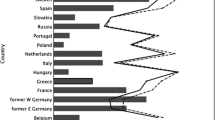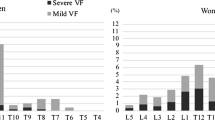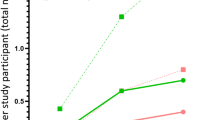Summary
□Background: The prevalence of radiographically defined vertebral deformities, as a marker of vertebral osteoporosis, was calculated in a population based cross-sectional survey in Germany.
□Method: Lateral spine X-rays were taken according to a standardized protocol and evaluated centrally. Three thousand nine hundred and eighty subjects (2064 male and 1916 female) aged 50 to 79 years, have been examined in 8 German centers.
□Results: Based on McCloskey’s method of deformity definition the age-standardized mean prevalence of vertebral deformities in Germany was 10.2% for males and 10.5% for females. Based on the definition by Melton/Eastell as significant higher prevalence was calculated (males 17.8%, females 18.7%). The prevalence increased with age in both sexes with a steeper increase in females. There was no difference in East and West German populations. There were substantial variations between the centers regarding the prevalence of deformities in females and males.
Similar content being viewed by others
Literatur
Bengner U, Johnell O, Redlund-Johnell I. Changes in incidence and prevalence of vertebral fractures during 30 years. Calcif Tissue Int 1988;42:293–6.
Bernstein DS, Sadowsky N, Hegsted DM, Guri CD, Stare EJ. Prevalence of osteoporosis in high- and low-fluoride areas in North Dakota. JAMA 1966;198:499–504.
Consensus conference: Osteoporosis. JAMA 1984;252:799–802.
Cummings SR. Epidemiology of osteoporotic fractures. In: Genant HK, ed. Osteoporosis Update 1987. San Francisco: UCSF Printing Service, 1987.
Cummings SR, Kelsey JL, Nevitt MC, O’Dowd KJ. Epidemiology of osteoporosis and osteoporotic fractures. Epidemiol Rev 1985;7:178.
Eastell R, Cedel SL, Wahner HW, Riggs BL, Melton LJ III. Classification of vertebral fractures. J Bone Miner Res 1991;6:207–15.
Felsenberg D, Gowin W, Diessel E, Armbrust S, Mews J. Recent developments in DXA: quality of new DXA/MXA-devices for densitometry and morphometry. Europ J Radiol 1995;20:179–84.
Felsenberg D. Differentialdiagnose osteoporotischer Wirbelkörperfrakturen. In: Ringe JD, Meunier PJ, Hrsg. Senile Osteoporse. Stuttgart: Thieme-Verlag, 1996:73–91.
Felsenberg D, Kalender WA. Computerassisted morphometry of vertebral bodies. In: Vertebral fracture in osteoporosis. Genant HK, Jergas M et al., eds. San Francisco: UCSF-Print, 1996.
Felsenberg D. In: Metabolische Osteopathien. Seibel M, Stracke H, Hrsg. Stuttgart: Schattauer Verlag, 1997.
Goldsmith NF, Johnston JO, Picetti G, Garcia C. Bone mineral in the radius and vertebral osteoporosis in an insured population. J Bone Joint Surg 1973;55-A:1276–93.
Gowin W, Müller C, Alenfeld F, Diessel E, Felsenberg D. Differential diagnosis of osteoporotic vertebral fractures/deformities. J Bone Miner Res 1996;11(Suppl):355.
Gowin W, Diessel E, Mews J, Hoja T, Felsenberg D. Vertebral morphometry with DXA/MXA equipment — an equipment comparison. Dual X-ray absorptiometry/morphometric X-ray absorptiometry. Röfo 1997;166:140–5.
Kalidis L, Felsenberg D, Kalender WA, Eidloth H, Wieland E. Morphometric analysis of digitized radiographs: description of automatic evaluation. In: Current research in osteoporosis and bone mineral measurement II: 1992. Ring FFJ, ed. British Inst Radiol, 1992:14–6.
Lutwag L, Whedon GD. Osteoporosis. DM Disease-amonth 1963:1–39.
McCloskey EV, Spector TD, Eyres KS et al. The assessment of vertebral deformity: a method for use in population studies and clinical trials. Osteoporosis 1993;3:138–47.
Melton LJ III, Kann SH, Frye MA, Wahner HW, O’Fallon WM, Riggs BL. Epidemiology of vertebral fractures in women. Am J Epidemiol 1989;129:1000–11.
O’Neill TW, Felsenberg D, Varlow J, Cooper C, Kanis JA, Silman AJ, and the EVOS-Group: The prevalence of vertebral deformity in European men and women: The European Vertebral Osteoporosis Study. J Bone Miner Res 1996;11:1010–8.
Pogrund H, Makin M, Robin G, Menczel J, Steinberg R. Osteoporosis in patients with fractured femoral neck in Jerusalem. Clin Ortop 1977;124:165–72.
Riggs BL, Melton LJ III. Medical Progress: Involutional osteoporosis. N Engl J Med 1986;314:1676–84.
Wieland EU. Bestimmung der Wirbelkörpergeometrie zur Diagnose der Osteoporose. Freie Universität Berlin, 1993. Dissertation.
Author information
Authors and Affiliations
Consortia
Corresponding author
Rights and permissions
About this article
Cite this article
Felsenberg, D., Wieland, E., Hammermeister, C. et al. Prävalenz der vertebralen Wirbelkörperdeformationen bei Frauen und Männern in Deutschland. Med Klin 93 (Suppl 2), 31–34 (1998). https://doi.org/10.1007/BF03041996
Issue Date:
DOI: https://doi.org/10.1007/BF03041996




